
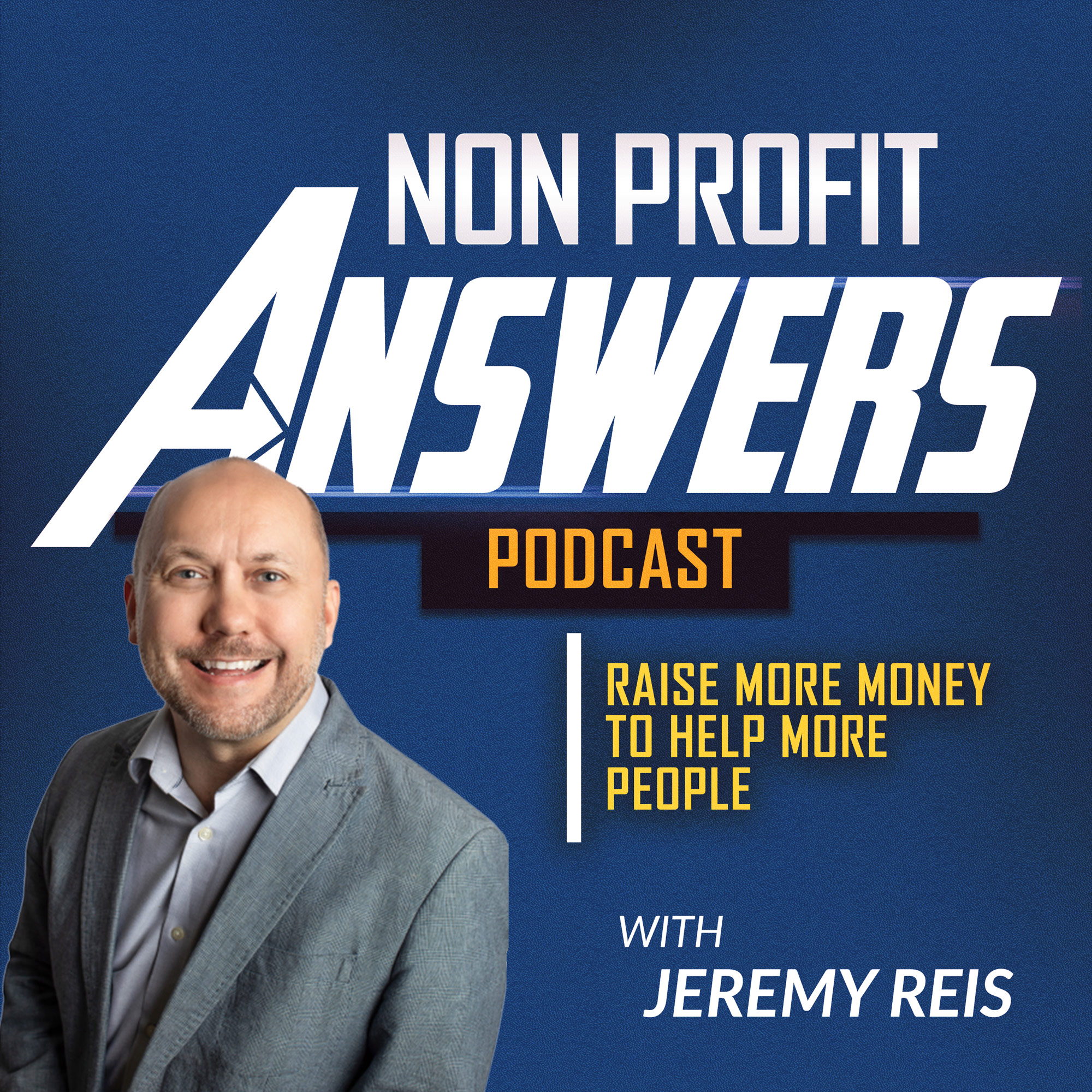
14.5K
Downloads
63
Episodes
Nonprofit Answers Podcast helps you raise more money to help more people by answering your nonprofit leadership, marketing, and fundraising questions. Learn how to reach more donors with answers to your philanthropy and advancement questions. For Development Directors, Chief Development Officers, CEOs, Nonprofit Leaders, Fundraisers, Marketing Managers, Major Donor Reps, and Nonprofit Board Members. Learn about monthly, annual fund, major, midlevel, grants, planned giving, direct mail, email fundraising, leadership, and more.
Episodes
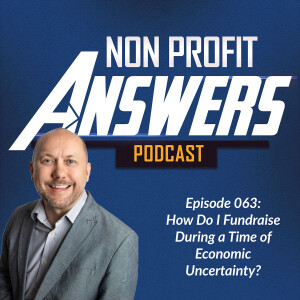
Tuesday Jun 17, 2025
063 - How Do I Fundraise During Times of Economic Insecurity?
Tuesday Jun 17, 2025
Tuesday Jun 17, 2025
Fundraising During Economic Uncertainty: How to Raise Money When Everyone's Worried
Built by nonprofit professionals, for nonprofit professionals. NonprofitPrompt takes the guesswork out of AI content creation with proven prompts for fundraising appeals, donor communications, and more. Join fellow nonprofit leaders at nonprofitprompt.com
The Challenge
When the economy is uncertain, inflation is high, and people are worried about their financial future, many nonprofits face a dilemma: Should they continue fundraising or is it insensitive to ask for money when everyone's struggling? This episode addresses this critical question through Patricia's situation - her Tampa homeless shelter has seen online donations drop 25% while demand for services has increased dramatically.
The Key Insight
Economic uncertainty doesn't mean you should stop fundraising - it means you need to fundraise differently.During tough times, people don't stop giving; they give more carefully and strategically. They become more selective about where they give, more focused on impact, and more concerned about organizational stability.
Seven Strategic Adaptations for Economic Uncertainty
1. Lead with Increased Community Need, Not Organizational Need
- Focus on how economic conditions create greater community need
- Position donor giving as community investment, not organizational bailout
- Example: "As inflation affects Tampa families, 40% more families need shelter" vs. "We need funding to keep our doors open"
2. Emphasize Immediate, Tangible Impact
- Donors want clear, immediate results during uncertain times
- Focus on direct services rather than capacity building
- Be specific: "$75 provides three nights of emergency shelter" vs. "Your gift supports our programs"
3. Offer Smaller Giving Options with Clear Impact
- Create compelling opportunities for smaller gifts
- Add lower giving levels: if you typically ask for $100-500, add $25-100 options
- Each level needs specific impact: "$25 provides emergency meals for three days"
4. Focus on Stewardship and Retention Over Acquisition
- Keeping existing donors is more cost-effective than finding new ones
- Increase thank-you calls, impact updates, and personal attention
- Help current donors feel so connected they maintain giving while reducing support elsewhere
5. Demonstrate Financial Responsibility and Stability
- Be transparent about challenges while showing responsible management
- Share program expense ratios, reserves, and board oversight
- Frame challenges in terms of community need: "We've reviewed our budget to ensure every dollar helps people"
6. Create Urgency Around Community Need, Not Organizational Survival
- Wrong: "We need $50,000 to keep programs running"
- Right: "We need $50,000 to shelter families facing eviction due to economic stress"
- Make donors feel like community rescuers, not organizational bailouts
7. Leverage Partnerships and Matching Opportunities Aggressively
- Donors want gifts to go further during tough times
- Promote matching gifts heavily: "Every dollar doubled for families in crisis"
- Create collaborative opportunities with businesses and foundations
Addressing Common Concerns
"Isn't it insensitive to ask during hard times?" People often want to help more during uncertainty because they understand financial worry. Acknowledge conditions: "We know times are challenging. That's why your support matters so much."
"Won't donors give less?" Some will, and that's okay. A donor reducing from $500 to $200 is still a donor. A donor who stops entirely because you stopped asking is a lost relationship.
"Should we cancel major gift asks?" Never. Major donors are often least affected and may increase giving. Focus on immediate impact and be sensitive to those affected by losses.
Success Story
A food bank during the 2008 recession saw 60% increased demand and 20% decreased revenue. By implementing these strategies - focusing on community hunger rather than budget shortfalls, creating smaller giving options, and increasing donor stewardship - they recovered lost revenue and increased it by 15% within eight months while building stronger donor relationships.
Key Takeaway
Community need likely increases during tough times, making the case for supporting your organization stronger, not weaker. Economic uncertainty creates both challenges and opportunities. Organizations that adapt their fundraising strategies to match donor psychology during difficult periods often emerge with stronger relationships and more sustainable revenue.
The goal isn't to avoid fundraising during uncertainty - it's to fundraise more strategically, acknowledging economic realities while demonstrating urgent community need.
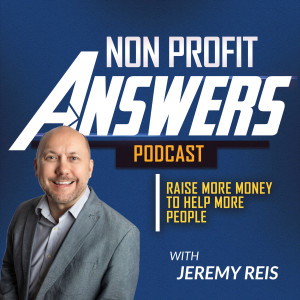
Monday Jun 16, 2025
062 - How Do I Create a Donor Stewardship Calendar?
Monday Jun 16, 2025
Monday Jun 16, 2025
The Donor Stewardship Calendar: Stop Losing Donors Between Campaigns
Tired of getting generic responses from ChatGPT for your nonprofit content? NonprofitPrompt provides expert AI prompts built specifically for fundraising, donor stewardship, and grant writing. Finally, AI that understands your mission. Get a free account at nonprofitprompt.com
It's March and you suddenly realize you haven't contacted donors since December. Sound familiar?
You're great at running campaigns - your year-end appeal crushed it, your spring event was a success - but then... radio silence. Donors hear from you only when you need money, and you wonder why retention rates keep dropping and supporters seem less engaged each year.
What You'll Discover in This Episode
The counterintuitive truth: The nonprofits with the highest donor retention don't ask for money less often - they ask MORE often while providing tremendous value between asks.
The game-changing strategy: How to create a systematic donor stewardship calendar that combines regular fundraising with impact reporting, turning every communication into both relationship-building AND revenue generation.
What's Inside the Framework
- Monthly communication strategy that donors actually appreciate (hint: it's not about asking less)
- The dual-purpose content formula that shows impact while creating giving opportunities
- Segmentation secrets for different donor engagement levels
- 12-month calendar template with specific examples for each month
- The integration method that makes fundraising feel like partnership, not pestering
Real Results You'll Hear About
A social services nonprofit afraid they were "too pushy" completely transformed their approach:
- 40% increase in revenue (more opportunities = more gifts)
- 30% improvement in retention (regular connection = stronger loyalty)
- Donors writing thank-you notes for keeping them informed about impact
One donor said: "I love that you keep me updated on both the needs and the progress. It makes me feel like a real partner in your work, not just someone you ask for money."
Perfect For Veterans Services (and Every Other Nonprofit)
Michael from a veterans nonprofit gets specific strategies for showing measurable outcomes - veterans finding jobs, securing housing, successful transitions - while maintaining consistent giving opportunities.
The Bottom Line
Donors don't get tired of hearing from organizations they care about. They get tired of hearing from organizations that only contact them for money or provide no value.
Ready to transform scattered, guilty communications into a strategic system that builds relationships AND raises more money? This episode gives you the exact month-by-month blueprint that turns donor stewardship from an afterthought into your secret retention weapon.
Stop losing donors between campaigns. Start building the kind of ongoing relationships that create lifelong supporters.
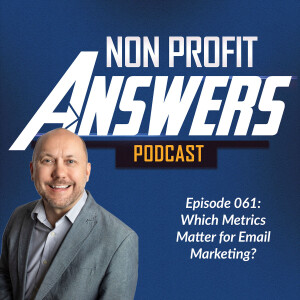
Friday Jun 13, 2025
061 - Which Email Metrics Matter?
Friday Jun 13, 2025
Friday Jun 13, 2025
Your 28% Email Open Rate Means Nothing (Here's What Actually Matters)
Transform your AI results from bland to brilliant. NonprofitPrompt provides sector-specific prompts that turn ChatGPT and Claude into your most effective fundraising tool. Created for nonprofit professionals who need content that converts. Get a free account at nonprofitprompt.com
Your appeal email had a 35% open rate but only raised $500. Your newsletter had a 22% open rate but generated $8,000 in donations. Which one was more successful?
If you answered based on open rates, you're making the same costly mistake that's sabotaging nonprofit email programs everywhere.
Steven from a Seattle homeless services nonprofit perfectly illustrates this problem: His open rates improved by 8 percentage points (now consistently 26-28%), but his email fundraising results stayed completely flat at $15,000 per year. Great engagement, terrible results.
Here's the hard truth: Email open rates are a vanity metric that can actually hurt your fundraising when you optimize for them.
What You'll Learn in This Episode:
✅ Why open-rate optimization destroys fundraising results (and the psychological trap that keeps nonprofits focused on the wrong metrics)
✅ The 6 email metrics that actually correlate with donations:
- Click-through rates vs. open rates
- Time spent reading (not just opening)
- Response rates that generate revenue
- List quality over list size
- Conversion from email to actual donation
- Unsubscribe patterns that reveal what donors really want
✅ The case study that proves everything: One organization decreased open rates from 25% to 21% but increased email revenue by 180%
✅ 5 specific strategies to optimize for results instead of vanity metrics:
- Why "You won't believe what happened" subject lines kill long-term engagement
- How to write subject lines that attract donors, not browsers
- The segmentation strategy that turns casual subscribers into committed supporters
The Bottom Line:
A smaller list of engaged supporters will always outperform a larger list of casual observers. Opens don't pay the bills—conversions do.
Perfect for: Communications directors, development professionals, and anyone frustrated that their "great" email metrics aren't translating into actual fundraising success.
The wake-up call your email program needs: Stop celebrating the wrong numbers and start measuring what actually moves your mission forward.
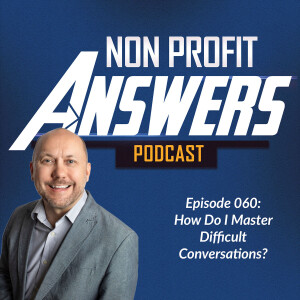
Thursday Jun 12, 2025
060 - How Do I Master Difficult Conversations?
Thursday Jun 12, 2025
Thursday Jun 12, 2025
The Difficult Conversation Playbook: How to Address Problems Without Destroying Relationships
I've created a new tool: Built by nonprofit professionals, for nonprofit professionals. NonprofitPrompt takes the guesswork out of AI content creation with proven prompts for fundraising appeals, donor communications, and more. Join fellow nonprofit leaders at nonprofitprompt.com
Ever promise a donor something you can't deliver? Had a board member storm out of a meeting? Watched a star employee quit because you avoided addressing performance issues?
Every nonprofit leader faces conversations that make their stomach churn - with staff who aren't performing, board members overstepping boundaries, or donors with unrealistic expectations. Most of us either avoid these conversations until they explode into crises, or dive in unprepared and make everything worse.
What You'll Learn in This Episode
The counterintuitive truth: The leaders who excel at difficult conversations aren't naturally comfortable with conflict - they just have better frameworks for approaching these situations strategically rather than reactively.
The 6-step framework that transforms difficult conversations from relationship-killers into relationship-strengtheners:
- Thorough preparation (most conversations fail before they start)
- Starting with shared goals (collaborative vs. adversarial tone)
- Focusing on behaviors, not personalities (the game-changing difference)
- Active listening (understanding the real problem)
- Collaborative solutions (specific expectations and support)
- Consistent follow-up (ensuring lasting change)
Real Scenarios Covered
- The performance conversation that saved a struggling development director's job and led to record fundraising
- Boundary-setting with micromanaging board members without burning bridges
- Managing donor expectations when you can't deliver what they want
- Conflict resolution that strengthens teams instead of dividing them
The Bottom Line
Avoiding difficult conversations doesn't protect relationships - it destroys them slowly. When you master these conversations, you create environments where problems get solved quickly, expectations are clear, and relationships are built on honesty and mutual respect.
Ready to stop dreading these conversations and start seeing them as opportunities to strengthen your organization? Listen now for the specific phrases, preparation strategies, and follow-up techniques that turn your most challenging leadership moments into your greatest successes.
Perfect for: Executive directors, development professionals, program managers, and anyone who needs to address performance, conflict, or change while maintaining strong working relationships.
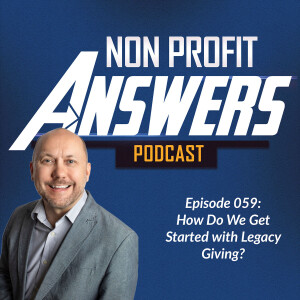
Wednesday Jun 11, 2025
059 - How Does My Nonprofit Get Started with Legacy Giving?
Wednesday Jun 11, 2025
Wednesday Jun 11, 2025
Why Your Small Nonprofit Is Missing Out on $50,000+ Legacy Gifts (And How to Fix It)
Transform your AI results from bland to brilliant. NonprofitPrompt provides sector-specific prompts that turn ChatGPT and Claude into your most effective fundraising tool. Created for nonprofit professionals who need content that converts. Get a free account at https://nonprofitprompt.com
A 78-year-old woman walks into your office and says she wants to put your organization in her will. Your heart races—then panic sets in because you have absolutely no idea what to tell her.
This actually happened to Jennifer, executive director of a small literacy nonprofit in Boise. Her organization just received an unexpected $85,000 bequest from a donor they'd never even heard of—someone who had been quietly reading their newsletters for years and decided to leave them money in her will.
Here's the shocking truth: Most small nonprofits think legacy giving is only for large organizations with dedicated staff and wealthy donors. They're completely wrong.
In this episode, you'll discover:
✅ Why modest $50-100 annual donors are leaving $200,000+ bequests (and how to identify them)
✅ The 7 simple strategies that make planned giving work for small nonprofits without hiring specialists or spending money you don't have
✅ The biggest barrier to legacy gifts (hint: it's not donor capacity—it's organizational fear)
✅ Exact language you can use immediately in newsletters and thank-you letters to plant the planned giving seed
✅ How one small historical society identified 12 planned gift commitments in 3 years and increased annual giving by 40%
The reality check: Legacy gifts aren't about wealthy donors—they're about committed donors who want their values to outlive them. And your most loyal supporters are making estate plans right now without ever being asked to consider your organization.
Stop leaving transformational gifts on the table. This episode gives you everything you need to start meaningful legacy giving conversations today—no legal expertise required.
Perfect for: Executive directors, development coordinators, and anyone at a small nonprofit who thinks planned giving is "too complicated" for their organization.
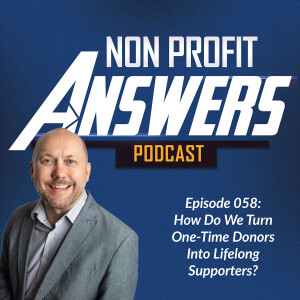
Tuesday Jun 10, 2025
058 - How Do We Turn One-Time Donors Into Lifelong Supporters?
Tuesday Jun 10, 2025
Tuesday Jun 10, 2025
Stop Losing 70% of Your First-Time Donors: The 90-Day Game Plan That Changes Everything
But before we get to the episode, let me tell you about a new platform I created just for you. Stop wasting hours crafting AI prompts that deliver mediocre results. NonprofitPrompt gives you expert-crafted prompts that generate compelling donor appeals, grant proposals, and stewardship content in minutes. Get your free account at https://nonprofitprompt.com.
You're doing great at attracting new donors, but here's the brutal truth: most nonprofits lose 70% of first-time donors who never give a second gift. If this sounds familiar, you're literally watching potential lifelong supporters slip through your fingers—and missing out on massive revenue.
What if there was a proven system to flip those numbers?
In this episode, host Jeremy Reis reveals the 90-day cultivation journey that transforms one-time donors into committed supporters. You'll discover why the first 90 days after someone's initial gift is the make-or-break period that determines whether they'll support you for one year or twenty years.
You'll learn the exact 7-step sequence that successful organizations use:
- The 24-hour acknowledgment that makes donors feel truly seen (not just receipted)
- The one-week impact report that shows their specific gift in action
- Why personal connection within 30 days skyrockets retention rates
- The "insider access" psychology that creates belonging
- When and how to make that crucial second ask
Real results: One animal shelter used this system to boost their retention rate from 17% to 25% in just one year, with retained donors giving 40% more in their second year.
Perfect for: Development staff and nonprofit leaders who are tired of the "acquire and pray" approach to donor cultivation.
Featured: Angela from a Richmond food pantry who brought in 800 new donors but kept only 12%—and the specific strategies that can turn her numbers around.
The bottom line: Stop treating donors like transactions and start treating them like the lifetime partners they could become. This episode gives you the exact roadmap to make it happen.
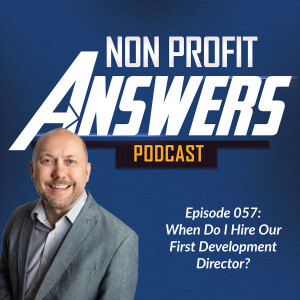
Monday Jun 09, 2025
057 - When Should I Hire Our First Development Director?
Monday Jun 09, 2025
Monday Jun 09, 2025
Ready to Hire Your First Development Director? This Episode Is Your Roadmap to Success
Tired of getting generic responses from ChatGPT for your nonprofit content? NonprofitPrompt provides expert AI prompts built specifically for fundraising, donor stewardship, and grant writing. Finally, AI that understands your mission. Get your free account at https://nonprofitprompt.com
If you're an executive director who's been juggling fundraising with everything else and your board is pushing you to hire your first development director, this episode is exactly what you need. Host Jeremy Reis tackles the biggest fears and questions around this critical hire: What should you look for in candidates? How much should you pay? How do you transition donor relationships without losing them?
You'll discover:
- Why the skills that made YOU successful at fundraising are different from what your development director needs
- The biggest mistake nonprofits make when writing job descriptions (and how to avoid it)
- Whether to hire for experience or potential (the answer might surprise you)
- A realistic salary range for organizations with budgets like yours
- How to manage the 12-18 month ramp-up period without panicking about immediate results
- A proven strategy for transitioning donor relationships that keeps everyone happy
Action Item: Write a customized job description that reflects your organization's actual needs and current fundraising activities.
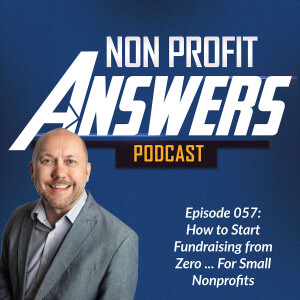
Friday Jun 06, 2025
056 - How to Start Fundraising From Zero
Friday Jun 06, 2025
Friday Jun 06, 2025
Master Class From Zero: Build a Fundraising Program That Actually Works (Even If You're Starting with Nothing)
Starting fundraising from scratch? Overwhelmed by all the advice telling you to do everything at once? Most fundraising guidance assumes you already have donors, systems, and resources - but what if you're literally starting with zero?
This isn't another generic fundraising overview. This is the step-by-step roadmap for building sustainable fundraising from the ground up, designed specifically for new nonprofits, organizations that have never done systematic fundraising, or leaders who've inherited programs that aren't working.
In this comprehensive master class, you'll discover:
- The Foundation First Principle - why starting with systems before donors prevents the chaos that destroys most new fundraising programs
- Your First Donor Strategy - how to identify and cultivate supporters from your existing network when you have no donor database
- The Three-Channel Approach that builds sustainable revenue without overwhelming your capacity (and why trying to do everything leads to doing nothing well)
- Board Fundraising for Reluctant Members - how to get board support and participation even when they "don't like asking for money"
- Essential Systems on a Budget - the minimum technology and processes you need to track donors and measure success without breaking the bank
- The 18-Month Timeline that shows exactly when to add each fundraising activity so you build momentum instead of burning out
- Revenue Goal Reality Check - how to set fundraising targets that challenge you without setting you up for failure
Perfect for: New executive directors, organizations launching their first real fundraising efforts, and leaders who feel like they're throwing spaghetti at the wall hoping something sticks.
The reality check: You don't need a million-dollar budget or decades of experience to build effective fundraising. You need the right sequence, realistic expectations, and systems that match your actual capacity.
Why this approach works: Instead of trying to copy what established organizations do, you'll build a program designed for your size, resources, and goals - one that grows with you instead of overwhelming you.
One startup nonprofit went from having no systematic fundraising to raising $45,000 in their first year using this foundation-first approach.
Stop feeling behind and start building the fundraising foundation your mission deserves.
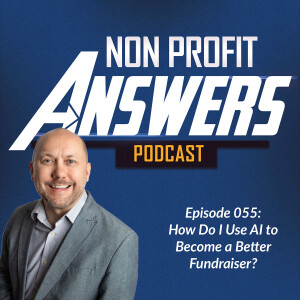
Wednesday Jun 04, 2025
055 - Vibe Fundraising: How Do I Use AI to Increase Fundraising?
Wednesday Jun 04, 2025
Wednesday Jun 04, 2025
Nonprofit development teams are overwhelmed with time-consuming manual tasks. While one team spends days on prospect research and weeks writing grants, AI-enabled organizations are accomplishing the same work in hours or minutes, identifying more prospects and creating personalized outreach at unprecedented scale.
What is Vibe Fundraising?
Vibe Fundraising is an AI-powered approach to nonprofit development that uses readily available tools like ChatGPT and Claude (around $20/month) to handle time-consuming tasks, freeing up staff to focus on relationship building and strategic work. The concept comes from "vibe coding" and "vibe marketing" - using AI to amplify professional capabilities rather than replace human expertise.
Key principle: This isn't about replacing human relationships or buying expensive software - it's about using AI to handle research and drafting so you can spend more time on what matters most.
Five Practical AI Applications for Fundraisers
1. AI-Powered Prospect Research
- Traditional way: Hours of manual database searches and article reading
- AI approach: Compress research into minutes with targeted prompts
- Example prompt: "Research these five business owners as major gift prospects for children's literacy. Identify: business background, philanthropic history, connection points to education, and suggested talking points."
2. Personalized Donor Communications at Scale
- Create customized appeals for different donor segments instead of generic mass mailings
- Example: Adapt one case for support into separate versions for teachers ($100-500 donors), parents ($50-250), and retired professionals ($500-2000)
- Each version references specific motivations and uses appropriate language
3. Grant Writing and Foundation Research
- Research: "Help me create a strategy to identify foundations funding children's literacy in Colorado - types to target, search terms, evaluation criteria"
- Writing: Generate compelling needs statements and program descriptions that you refine with local data
- Result: Cut grant writing time in half while improving proposal quality
4. Donor Stewardship and Thank-You Communications
- Create meaningful thank-you templates for different donor categories
- Generate donor appreciation ideas for various budgets
- Ensure timely, personalized stewardship that improves retention
5. Campaign Strategy and Messaging Development
- Develop campaign themes and messaging for different audiences
- Create multiple case statements emphasizing different benefits (community impact, educational outcomes, economic benefits)
Addressing Common Concerns
"Will this feel impersonal?" Use AI as a research assistant and first draft writer, not your final voice. Always review, edit, and add personal touches.
"What about accuracy?" AI can make mistakes. Always verify facts, figures, and donor data. Use AI for structure and ideas, confirm details yourself.
"Is this ethical?" Absolutely, as long as you're transparent and maintain authentic relationships. You're using technology to better serve your mission and donors.
Getting Started: 5-Day Implementation Plan
- Day 1: Sign up for ChatGPT Plus or Claude Pro ($20/month)
- Day 2: Practice prospect research on three potential donors
- Day 3: Use AI to improve an existing appeal or thank-you letter
- Day 4: Try grant research assistance for current priorities
- Day 5: Use AI for brainstorming fundraising challenges
Success Story
A development director at an environmental nonprofit cut prospect research time in half and submitted 40% more grant applications using AI. The time savings allowed deeper major gift conversations, resulting in two six-figure commitments. AI amplified her expertise rather than replacing it.
Key Takeaways
- Start small: Gradually expand AI use as you gain comfort
- Strategic focus: Work more strategically, not necessarily less
- Human element remains central: AI handles routine tasks so you can focus on relationships
- Competitive advantage: Early adopters will have significant advantages over organizations that wait
- Accessibility: No technical expertise required - just willingness to try new tools
The goal is freeing up time for what drew you to nonprofit work: building relationships and creating positive change in the world.
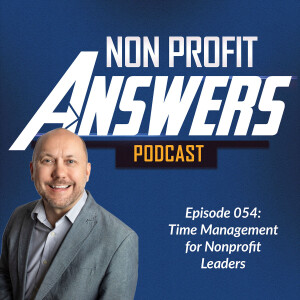
Tuesday Jun 03, 2025
054 - Time Management for Nonprofit Leaders
Tuesday Jun 03, 2025
Tuesday Jun 03, 2025
Nonprofit leaders often find themselves working 60+ hour weeks, constantly reactive to urgent demands, and struggling to balance operational fires with strategic priorities. Unlike corporate environments, nonprofit work presents unique challenges where everything feels both urgent and mission-critical - from serving people in need to cultivating donors to supporting staff.
Key Insight
Traditional time management advice fails in nonprofit settings because it assumes you can simply say "no" to less important activities. In nonprofit work, distinguishing what's truly less important is difficult when dealing with human needs, donor relationships, and community impact. The solution isn't working faster - it's developing systems for ruthless prioritization and strategic delegation.
Seven Time Management Strategies for Nonprofit Leaders
1. Mission-Impact Matrix
Replace traditional urgent/important categorization with a system that evaluates activities based on:
- High Mission Impact + High Organizational Impact: Strategic planning, major donor cultivation (gets prime time)
- High Mission Impact + Low Organizational Impact: Direct service delivery (delegate when possible)
- Low Mission Impact + High Organizational Impact: Systems development (often overlooked but crucial)
- Low Mission Impact + Low Organizational Impact: Administrative tasks (minimize or eliminate)
2. CEO Time Blocks
Schedule unmovable time blocks for strategic activities rather than treating them as optional add-ons. Block specific times weekly for donor cultivation, strategic planning, or staff development, and protect these blocks from interruptions except genuine emergencies.
3. Systematic Delegation
Effective delegation requires:
- Documenting processes and decision-making criteria
- Providing initial training and ongoing support
- Establishing clear quality standards and checkpoints
- Creating feedback loops and accountability measures
4. Activity Batching
Group similar activities together to reduce mental energy lost in task-switching:
- Batch all donor calls into specific time blocks
- Process emails at designated times only
- Schedule similar meetings back-to-back
- Block uninterrupted time for writing projects
5. "Good Enough" Principle
Reserve perfectionism for truly critical activities (major donor proposals, strategic planning) while accepting "good enough" for less critical tasks (meeting minutes, newsletter layouts, routine communications).
6. Buffer Time
Schedule only 70-80% of your time, leaving 20-30% buffer for inevitable interruptions, emergencies, follow-ups, and relationship-building conversations.
7. "Stop Doing" Lists
Regularly audit and eliminate activities that no longer serve your mission:
- Unnecessary meetings
- Unused reports
- Outdated processes
- Misaligned commitments
Success Story
An executive director reduced her work week from 65 to 45 hours while improving organizational performance by implementing these strategies, leading to increased donor retention, improved staff morale, and stronger board relationships.
Immediate Action Steps
- Audit current weekly schedule using the Mission-Impact Matrix
- Protect 5-10 hours weekly for strategic activities
- Choose 2-3 operational responsibilities to delegate with proper systems
- Eliminate 2-3 low-impact activities
The goal isn't working less hard, but working more strategically to create maximum mission impact while building long-term organizational sustainability.